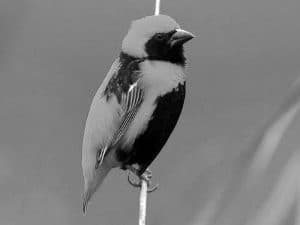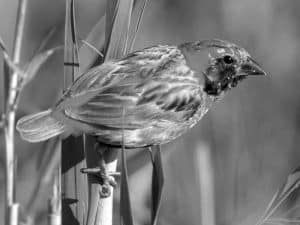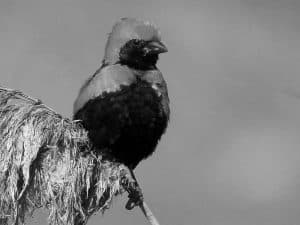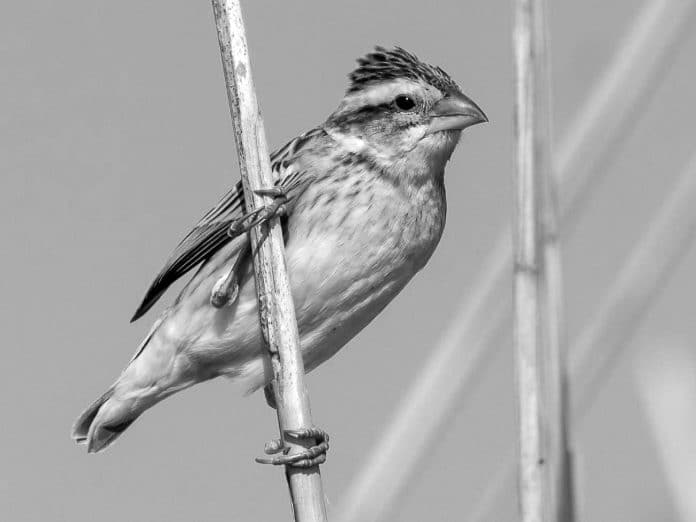Introduction to the Yellow-Crowned Bishop
Nestled within the diverse avian tapestry of Tanzania lies a true gem – the captivating Yellow-Crowned Bishop. This striking passerine bird is a true delight for birdwatchers and nature enthusiasts alike, captivating the senses with its vibrant plumage and captivating behavior. As you immerse yourself in the rich ecosystems of Tanzania, prepare to be enchanted by the splendor of this remarkable species the so called “Yellow-crowned bishop in Tanzania”.
Habitat and Distribution of the Yellow-Crowned Bishop in Tanzania

The Yellow-Crowned Bishop, scientifically known as Euplectes afer, is a resident species found throughout Tanzania’s varied landscapes. From the lush wetlands and marshes to the verdant grasslands and savannas, this resilient bird has adapted to thrive in a diverse array of habitats. Its range extends across the country, with notable populations found in regions such as the Serengeti National Park, Tarangire National Park, and the Ngorongoro Conservation Area.
Physical Characteristics and Behavior of the Yellow-Crowned Bishop
The Yellow-Crowned Bishop is a true feast for the eyes, with its striking plumage that sets it apart from other avian species. During the breeding season, the male birds don a stunning golden-yellow head and chest, complemented by a jet-black back and wings. This vibrant display is a testament to the species’ impressive adaptations, serving as a means of attracting mates and asserting territorial dominance. Outside of the breeding season, the birds adopt a more subdued brown and grey coloration, blending seamlessly into their surroundings.
Beyond their visual splendor, Yellow-Crowned Bishops exhibit a captivating array of behaviors. They are known for their energetic flight displays, where males perform intricate aerial maneuvers to impress potential mates. These acrobatic feats, coupled with their melodious vocalizations, create a mesmerizing show that captivates all who witness it.
Breeding and Mating Habits of the Yellow-Crowned Bishop
The breeding season of the Yellow-Crowned Bishop is a true spectacle to behold. During this time, the males engage in a captivating courtship ritual, establishing their territories and competing for the attention of females. They construct intricate nests, often woven from grasses and reeds, in which the females lay their clutch of eggs.
The females play a crucial role in the breeding process, carefully incubating the eggs and tending to the hatchlings. Once the chicks have fledged, the parents continue to provide care and protection, ensuring the survival of the next generation of Yellow-Crowned Bishops.
Diet and Feeding Patterns of the Yellow-Crowned Bishop
As adaptable foragers, Yellow-Crowned Bishops supplement their diet with a diverse array of food sources. They primarily feed on seeds, grains, and insects, gleaning from the rich ecosystems they inhabit. Their agile movements and keen eyesight allow them to locate and capture their prey with remarkable efficiency.
During the breeding season, the birds’ dietary preferences shift, with the males often supplementing their intake with nectar and pollen from flowering plants. This nutritional boost provides the energy necessary to sustain their energetic courtship displays and territorial defense.
Conservation Status and Threats to the Yellow-Crowned Bishop

The Yellow-Crowned Bishop is currently classified as a species of Least Concern by the International Union for Conservation of Nature (IUCN). However, like many avian species, it faces a range of threats that could potentially impact its long-term survival.
Habitat loss and degradation, driven by factors such as agricultural expansion, urbanization, and climate change, pose a significant challenge to the species. Additionally, the illegal wildlife trade and hunting for food or sport can further jeopardize the Yellow-Crowned Bishop’s populations.
Conservation efforts in Tanzania, led by both governmental and non-governmental organizations, aim to protect the species and its vital habitats. These initiatives include habitat restoration, community-based conservation programs, and public education campaigns to raise awareness about the importance of preserving Tanzania’s rich avian diversity.
The Importance of Birdwatching in Tanzania for Yellow-Crowned Bishop enthusiasts
Tanzania’s diverse ecosystems and abundance of avian species make it a premier destination for birdwatchers and nature enthusiasts. The Yellow-Crowned Bishop is just one of the many captivating birds that can be observed in the country, offering a unique opportunity to witness its vibrant colors and fascinating behaviors.
Birdwatching in Tanzania not only allows you to encounter the Yellow-Crowned Bishop but also introduces you to a plethora of other species, from the majestic Kori Bustard to the elusive Pel’s Fishing Owl. Each sighting becomes a treasured moment, fueling your appreciation for the natural wonders that Tanzania has to offer.
Tips for Spotting and Photographing the Yellow-Crowned Bishop in Tanzania
To make the most of your birdwatching experience in Tanzania, consider the following tips for spotting and photographing the Yellow-Crowned Bishop:
- Timing is Key: The best time to observe the Yellow-Crowned Bishop is during the breeding season, typically from March to August. This is when the males are in their full, vibrant plumage and engage in their most captivating behaviors.
- Habitat Identification: Familiarize yourself with the bird’s preferred habitats, such as wetlands, marshes, and grasslands. This knowledge will help you narrow down your search and increase your chances of encountering the Yellow-Crowned Bishop.
- Patience and Observation: Birdwatching requires a keen eye and a patient approach. Observe the bird’s movements, vocalizations, and interactions with its surroundings to gain a deeper understanding of its behavior and capture stunning photographs.
- Gear Preparation: Equip yourself with high-quality binoculars, a telephoto lens, and a sturdy tripod to enhance your birdwatching and photography experience. These tools will allow you to capture the Yellow-Crowned Bishop’s vibrant details and captivating movements.
- Respect the Environment: Remember to maintain a respectful distance from the birds and their habitats, minimizing any disturbance to the delicate ecosystems they inhabit.
Other Bird Species Found in Tanzania’s Ecosystems
While the Yellow-Crowned Bishop is undoubtedly a highlight, Tanzania’s avian diversity extends far beyond this captivating species. The country is home to a vast array of other birds, each with its own unique characteristics and behaviors.
Some notable species you may encounter during your birdwatching adventures in Tanzania include:
- The Kori Bustard, the world’s heaviest flying bird
- The Lilac-Breasted Roller, known for its stunning plumage and acrobatic flight displays
- The Masai Ostrich, the largest living bird species
- The Pel’s Fishing Owl, a rare and elusive predator found near waterways
- The Flamingo, with its iconic pink plumage, found in the country’s soda lakes
Conclusion: Appreciating the Beauty and Diversity of Tanzania’s Avian Wildlife

As you immerse yourself in the captivating world of the Yellow-Crowned Bishop in Tanzania, you’ll not only witness the splendor of this remarkable species but also gain a deeper appreciation for the country’s rich avian diversity. From the vibrant colors and energetic behaviors of the Yellow-Crowned Bishop to the myriad of other bird species that call Tanzania home, this East African nation offers a truly enchanting experience for birdwatchers and nature enthusiasts alike.

































